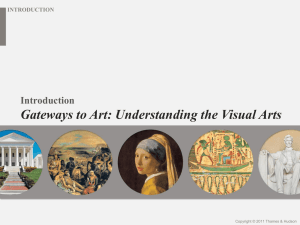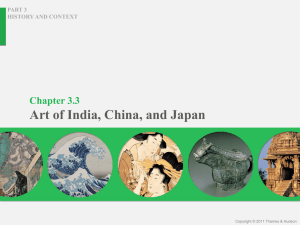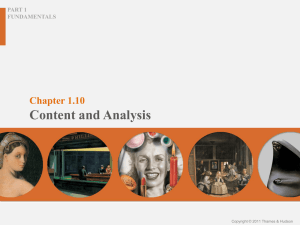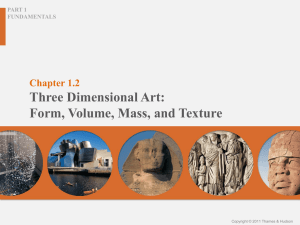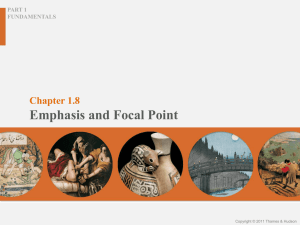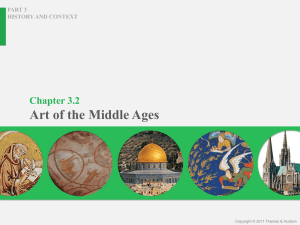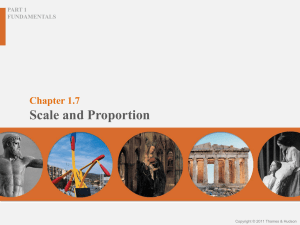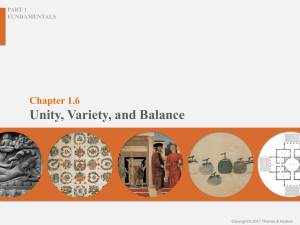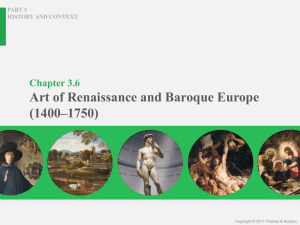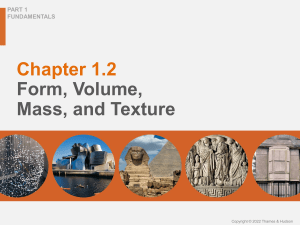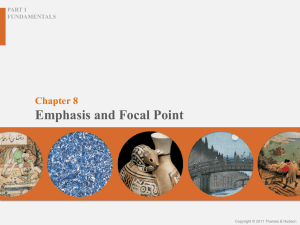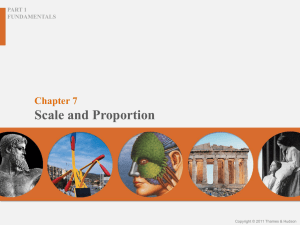Chapter 3.5 Gateways to Art: Understanding the Visual Arts By
advertisement
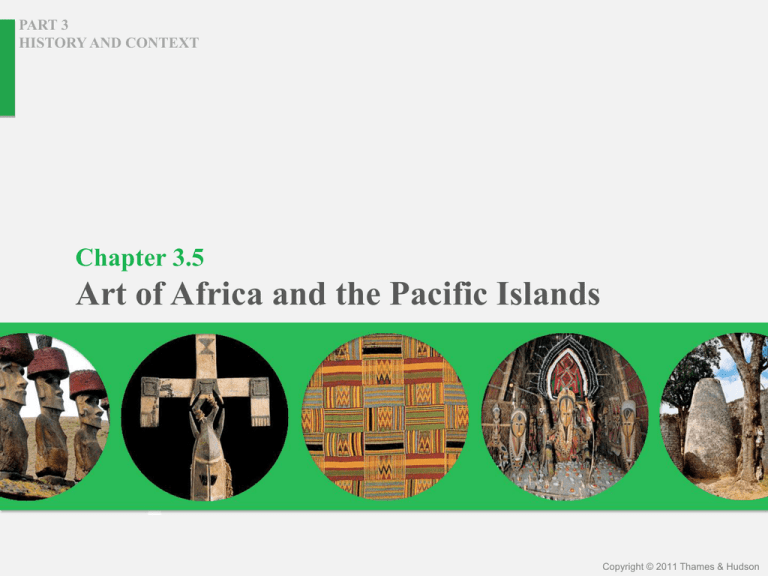
PART 3 HISTORY AND CONTEXT Chapter 3.5 Art of Africa and the Pacific Islands Copyright © 2011 Thames & Hudson Chapter 3.5 Art of Africa and the Pacific Islands PART 3 HISTORY AND CONTEXT Art of Africa Africa is a very diverse continent 54 different countries More than 955 million inhabitants At least 1,000 different languages Oral history has been more important than written documentation African art Important form of communication and cultural expression Earliest examples date back 75,000 years ago Gateways to Art: Understanding the Visual Arts, Debra J. DeWitte, Ralph M. Larmann, M. Kathryn Shields 3.101 Map of Africa Chapter 3.5 Art of Africa and the Pacific Islands PART 3 HISTORY AND CONTEXT Portraits and Power Figures Objects are invested with power Connect with supernatural realm Indicate authority to rule Channel supernatural forces that bestow good or ill fortune Objects communicate ideas Directly represent rules and customs Symbols of a particular role or position Tell stories Gateways to Art: Understanding the Visual Arts, Debra J. DeWitte, Ralph M. Larmann, M. Kathryn Shields 3.102 Head from Rafin Kura, c. 500 BCE–200 CE. Terracotta, 14¼” high. National Museum, Lagos, Nigeria 3.103 Twin figure, probably from Ado Odo in Yorubaland, pre-1877 (probably 19th century). Wood, 10” high. Linden Museum, Stuttgart, Germany 3.104 Standing male figure (nkisi Mangaaka), late 19th century. Wood, iron, raffia, ceramic, kaolin pigment, red camwood powder (tukula), resin, dirt, leaves, animal skin, and cowrie shell, 43¾ × 15½ × 11”. Dallas Museum of Art, Texas Chapter 3.5 Art of Africa and the Pacific Islands PART 3 HISTORY AND CONTEXT Personal Stories and Symbolism In Africa, information has traditionally been shared orally or visually Abstract designs and patterns Can be read and understood like representational imagery Symbols, colors, and materials can all communicate specific information about the maker or user of the artwork Gateways to Art: Understanding the Visual Arts, Debra J. DeWitte, Ralph M. Larmann, M. Kathryn Shields 3.105 Textile wrapper (kente), 20th century. Silk, 6’10⅝” long. National Museum of African Art, Smithsonian Institution, Washington, D.C. 3.106 Kanaga mask from Mali, Dogon culture, early 20th century. Polychrome wood, leather cords, and hide, 45¼” high. Musée Barbier-Mueller, Geneva, Switzerland Chapter 3.5 Art of Africa and the Pacific Islands PART 3 HISTORY AND CONTEXT African Architecture Many buildings made of perishable materials Wood Mud-brick Some ceremonial structures have been maintained, but others have fallen into ruin Symbolism and ornamentation of the structures communicate: Spiritual concerns Ties to ancestors Connections with nature Gateways to Art: Understanding the Visual Arts, Debra J. DeWitte, Ralph M. Larmann, M. Kathryn Shields 3.107 Monday market, Great Mosque, Djenné, Mali 3.108 Conical Tower, c. 1350–1450, Great Zimbabwe, Zimbabwe 3.109 Bird on top of stone monolith, 15th century. Soapstone, 14½” high (bird image). Great Zimbabwe Site Museum, Zimbabwe Chapter 3.5 Art of Africa and the Pacific Islands PART 3 HISTORY AND CONTEXT For further insights into the work of African artists, watch: The Master Sculptors of Benin and Ife Click the image above to launch the video Gateways to Art: Understanding the Visual Arts, Debra J. DeWitte, Ralph M. Larmann, M. Kathryn Shields Chapter 3.5 Art of Africa and the Pacific Islands PART 3 HISTORY AND CONTEXT Art of the Pacific Islands Geographic area covers islands in the Pacific Ocean Polynesia Melanesia Micronesia Australia Artworks include: Portable objects: jewelry, furniture, weapons Body ornamentation Wooden sculpture Paintings on rock Ceremonial architecture Gateways to Art: Understanding the Visual Arts, Debra J. DeWitte, Ralph M. Larmann, M. Kathryn Shields 3.110 Map of the Pacific Islands Chapter 3.5 Art of Africa and the Pacific Islands PART 3 HISTORY AND CONTEXT New Zealand Part of Polynesia Shared beliefs, languages, and customs Island south of Australia Inhabited by the Maori, who have an elaborate tradition of tattooing Earliest preserved bodies with abstract tattoos date to c. 3300 BCE Gateways to Art: Understanding the Visual Arts, Debra J. DeWitte, Ralph M. Larmann, M. Kathryn Shields 3.111 Sydney Parkinson, Drawing of traditional Maori tattoo, from A Journal of a Voyage to the South Seas (1784), Pl. 16 3.112 X-ray kangaroo rock painting, c. 1900. Ocher and kaolin paint, 6’9½” high. Kakadu National Park, Northern Territory, Australia Chapter 3.5 Art of Africa and the Pacific Islands PART 3 HISTORY AND CONTEXT Hawaii First inhabited by Polynesians from the Marquesas Islands c. 600 CE Tahitian settlers (c. 1100 CE) introduced: Social hierarchy based on Kapu (or taboo) system New host of gods and demigods King Kamehameha Unified warring factions during the 18th century In 1959 Hawaii became the 50th U.S. state Gateways to Art: Understanding the Visual Arts, Debra J. DeWitte, Ralph M. Larmann, M. Kathryn Shields 3.113 Feather cloak (Ahu’ula), known as Kearny Cloak, c. 1843. Red, yellow, and black feathers, olona cordage, fiber netting, 55¾” long. Bishop Museum, Honolulu, Hawaii Chapter 3.5 Art of Africa and the Pacific Islands PART 3 HISTORY AND CONTEXT Easter Island Polynesian island in the southern Pacific Ocean Small, isolated island 15 miles by 7½ miles 1,300 miles off the coast of Chile Famous for abstract monolithic stone sculptures called moai Meaning “seamount,” “image,” “statue,” or “bearers of the gift” Gateways to Art: Understanding the Visual Arts, Debra J. DeWitte, Ralph M. Larmann, M. Kathryn Shields 3.114 Moai ancestor figures, Ahu Nau Nau, Easter Island (Chile), before the 15 th century Chapter 3.5 Art of Africa and the Pacific Islands PART 3 HISTORY AND CONTEXT Papua New Guinea Part of Melanesia Very diverse indigenous population The Abelam people live in wetland areas In northern Papua New Guinea Farming is a principal activity Crops include yams, taro, bananas, and sweet potatoes Gateways to Art: Understanding the Visual Arts, Debra J. DeWitte, Ralph M. Larmann, M. Kathryn Shields 3.115 Yam mask, Abelam, Maprik district, Papua New Guinea. Painted cane, 18⅞” high. Musée Barbier-Mueller, Geneva, Switzerland 3.116 Interior of Abelam cult house, Bongiora, Maprik, Papua New Guinea, Melanesia. Museum der Kulturen, Basle, Switzerland Chapter 3.5 Art of Africa and the Pacific Islands PART 3 HISTORY AND CONTEXT Discussion Question 1. Discuss three artworks that have been used in a ritual context. Consider how they were made and why they might have been made that way. You might choose one work from another chapter in the textbook, for example: 1.158, 4.16, 4.39. Gateways to Art: Understanding the Visual Arts, Debra J. DeWitte, Ralph M. Larmann, M. Kathryn Shields Copyright © 2011 Thames & Hudson Chapter 3.5 Art of Africa and the Pacific Islands PART 3 HISTORY AND CONTEXT Discussion Question 2. Consider the ways that inanimate objects have been imbued with power. What has to be done to them for their power to be activated? What happens to that power over time? You might choose one work from another chapter in the textbook, for example: 4.26, 4.43, 4.134. Gateways to Art: Understanding the Visual Arts, Debra J. DeWitte, Ralph M. Larmann, M. Kathryn Shields Copyright © 2011 Thames & Hudson Chapter 3.5 Art of Africa and the Pacific Islands PART 3 HISTORY AND CONTEXT Discussion Question 3. Choose three artworks connected with family or ancestors. Consider how the artworks express ideas about family and ancestors and why these concepts might be important. You might choose one work from another chapter in the textbook, for example: 4.16, 4.24, 4.44. Gateways to Art: Understanding the Visual Arts, Debra J. DeWitte, Ralph M. Larmann, M. Kathryn Shields Copyright © 2011 Thames & Hudson Chapter 3.5 Art of Africa and the Pacific Islands PART 3 HISTORY AND CONTEXT Discussion Question 4. Mythology and legend have been very informative to the makers of art in these areas. Consider the stories that are being told according to the evidence we have about the artworks in this chapter. What kinds of information are we missing? How might we fill in the blanks? Gateways to Art: Understanding the Visual Arts, Debra J. DeWitte, Ralph M. Larmann, M. Kathryn Shields Copyright © 2011 Thames & Hudson Chapter 3.5 Art of Africa and the Pacific Islands PART 3 HISTORY AND CONTEXT This concludes the PowerPoint slide set for Chapter 3.5 Gateways to Art: Understanding the Visual Arts By Debra J. DeWitte, Ralph M. Larmann, M. Kathryn Shields Copyright © 2011 Thames & Hudson PowerPoints developed by CreativeMyndz Multimedia Studios Chapter 3.5 Art of Africa and the Pacific Islands PART 3 HISTORY AND CONTEXT Picture Credits for Chapter 3.5 3.101 3.102 3.103 3.104 3.105 3.106 3.107 3.108 3.109 3.110 3.111 3.112 3.113 3.114 3.115 3.116 Drazen Tomic National Museum, Lagos Linden Museum, Stuttgart Dallas Museum of Art, Foundation for the Arts Collection, Gift of the McDermott Foundation, 1996.184.FA National Museum of African Art, Smithsonian Institution, Washington, D.C. Musée Barbier-Mueller, Geneva © JTB Photo Communications, Inc./Alamy © Chris Howes/Wild Places Photography/Alamy Photo Barney Wayne Drazen Tomic pl. XVI from Parkinson, S., A Journal of a Voyage to the South Seas, 1784 Photo Paul S. C. Tacon Bishop Museum, Honolulu, Hawaii iStockphoto.com Musée Barbier-Mueller, Geneva Collected by G.F.N. Gerrits, Vb 28418-28471 (1972). Photo Peter Horner 1981 © Museum der Kulturen, Basel, Switzerland PowerPoints developed by CreativeMyndz Multimedia Studios
